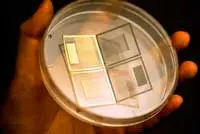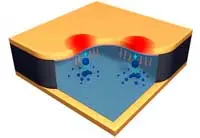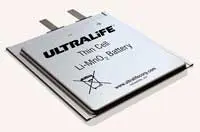Electronics News
Archive : 9 April 2017 год
 A method to make transistor-type active-matrix pressure sensors using foldable substrates and air-dielectric layers has been developed by researchers from the Korean Ulsan National Institute of Science and Technology.
A method to make transistor-type active-matrix pressure sensors using foldable substrates and air-dielectric layers has been developed by researchers from the Korean Ulsan National Institute of Science and Technology.
The 3D sensor is said to detect wide pressure ranges, from human body weight to a finger touch, and to generate an electrical signal based on the sensed touch actions, while consuming far less electricity than conventional pressure sensors.
According to the researchers, most transistors are created with a silicon channel and silicon oxide-based dielectrics. However, these transistors have been found to be either lacking transparency or flexibility, which hinders the development of highly-integrated pressure sensor arrays and transparent pressure sensors.
To create the sensors, the team decided to use highly conductive and transparent graphene transistors with air-dielectric layers.
"Using air as the dielectric layer in graphene FETs can significantly improve transistor performance due to the clean interface between graphene channel and air," says Jang-Ung Professor Park. "The thickness of the air-dielectric layers is determined by the applied pressure. With that technology, it is possible to detect pressure changes far more effectively."
In this transistor, the force pressing the elastic body is transferred to the air-dielectric layer and alters its thickness. The changes in the thickness are converted into an electrical signal and transmitted via metal nanowires and the graphene channel, expressing both the position and the intensity of the pressure.
"This sensor is capable of simultaneously measuring anything from lower pressure, such as gentle tapping, to high pressure, such as human body weight," explains PhD student Sangyoon Ji. "It can be applied to 3D touchscreen panels or smart running shoes."
Author
Peggy Lee
Source: www.newelectronics.co.uk
 A technology has been developed by engineers at Duke University to cool hotspots in high performance electronics.
A technology has been developed by engineers at Duke University to cool hotspots in high performance electronics.
"Hotspot cooling is important for high performance technologies," said associate professor Chuan-Hua Chen. "A better cooling system will enable faster computers, longer-lasting electronics and more powerful electric vehicles."
According to the researchers, when water droplets merge, the reduction in surface area causes the release of a small amount of energy. So long as the surface beneath is hydrophobic enough to repel water, this energy is sufficient to make the merged droplet jump away.
The technology relies on a vapour chamber made of a super-hydrophobic floor with a sponge-like ceiling. When placed beneath operating electronics, moisture trapped in the ceiling vaporises beneath emerging hotspots. The vapour escapes toward the floor, taking heat away from the electronics.
Passive cooling structures integrated into the floor of the device then carry away the heat, causing the water vapour to condense into droplets. As the growing droplets merge, they naturally jump off the hydrophobic floor and back up into the ceiling beneath the hotspot, and the process repeats itself. This is said to happen independently to gravity and regardless of orientation.
The research team claims the technology has many advantages over existing cooling techniques. Thermoelectric coolers cannot target random hotspot locations, making them inefficient for use over large areas. Other approaches can target moving hotspots, but require additional power inputs, which also leads to inefficiencies.
The jumping-droplet cooling technology also has a built-in mechanism for vertical heat escape, which is said to be a major advantage over today's heat spreaders that mostly dissipate heat in a single plane.
Pic: Heat vaporises water trapped in a sponge-like layer and the vapour droplets carry away heat. The vapour then coalesces on a super-hydrophobic floor, jumping back up beneath hotspots when they become large enough.
Author
Peggy Lee
Source: www.newelectronics.co.uk
 Ultralife has increased its Thin Cell range of primary lithium manganese dioxide (Li-MnO2) pouch-cell batteries. The batteries are said to be suitable for use in the next generation of internet-connected and wearable devices in sectors including medical, banking, highways, logistics, warehousing and security.
Ultralife has increased its Thin Cell range of primary lithium manganese dioxide (Li-MnO2) pouch-cell batteries. The batteries are said to be suitable for use in the next generation of internet-connected and wearable devices in sectors including medical, banking, highways, logistics, warehousing and security.
"The next generation of connected devices will have even more features packed into even more compact designs,” explained Dr Xulong Zhang, vice president of China sales and operational liaison. “To keep up with customer demand, device manufacturers need batteries that allow them to innovate.”
Operating at a nominal voltage of 3.0V, the pouch-cell batteries offer an energy density up to 500Wh/l and 400Wh/kg. Because the Thin Cell can be manufactured 0.4mm thick, the company claims device manufacturers can make their devices smaller without compromising run time.
The Thin Cell is also said to outperform coin cells when delivering high discharge rates because of optimised current collectors. The battery therefore meets the demands of devices that need high bursts of energy, such as those with RF transmitters.
Applications include RFID asset tracking systems in the logistics and warehousing sector, as well as wearable devices and drug delivery systems in medical environments. Other applications include bank theft tracking devices in the financial sector, smart devices in the security sector and toll pass tags in the highways sector.
"We've designed the Thin Cells to operate safely and effectively from -20 to 60°C, which means they continue to work long after other batteries have frozen,” said Zhang. “The Thin Cell also retains over 98% of its capacity after a year of storage at room temperature, so it does not suffer from the passivation that affects many other lithium chemistries."
The batteries are tested to the UL1642 requirements for safety, as well as UN testing for transportation.
Author
Peggy Lee
Source: www.newelectronics.co.uk
